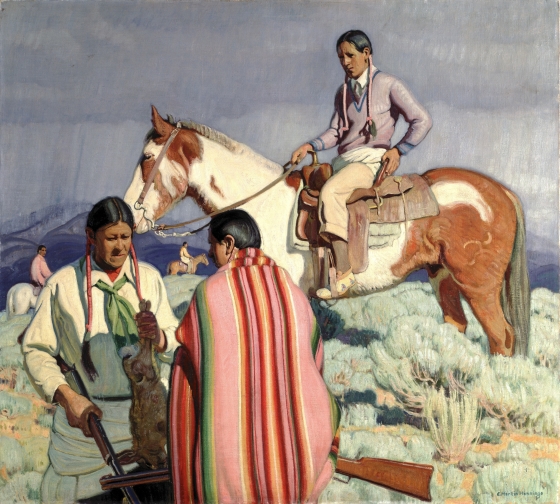Students will examine and discuss Rabbit Hunt by E. Martin Hennings and use clues from the painting to identify place, landscape, culture, and any other information describing the region depicted in the work. Students will compare this information to their own culture and region and create a postcard describing their community to someone who has never seen it.
Students will be able to:
- describe and analyze what they see in Rabbit Hunt;
- discuss distinctive regional aspects of geographical features, climate, and culture; and
- identify and create written or sketched representations of those ideas.
Lesson
- Show students Rabbit Hunt and have them examine and discuss what they see. Who is in the picture? Where are they? How do you know? What clues are there in the image that help us understand what is going on? What are the people doing? Share the information from the About the Art section. Tell students that Hennings was inspired by the landscape and people of the American Southwest.
- This picture was painted in Taos, New Mexico. What can we tell about the region and place where this was painted? What did the landscape look like? What was the culture of some of the people who lived there? What was the climate like? How can you tell? Notice the outfit worn by the man on the horse. He wears a combination of clothing that suggests the mixing of cultures in the Southwest. Notice his trousers, cuffed shirt, sweater, and moccasins. What are the other figures in the painting wearing?
- Ask students to imagine that someone is coming to their community, school, or home to paint their culture in this modern time. Ask them the following questions: What would the geographical features of the land look like? Would it look the same as in Rabbit Hunt? What would indicate the climate of the area where you live? Is there snow? What clothes would people be wearing? Are people wearing shorts? Would there be any other clues as to your culture or other cultures where you live?
- Explain that Hennings was sent to New Mexico by the Mayor of Chicago at the time, Mr. Harrison, who liked Hennings’s art as well as images of the Southwest, which were popular in the 1930s. These paintings were like postcards that told people from other places how the artist perceived New Mexico, through his own eyes and with his paintbrush. These paintings gave people from other places an idea of what New Mexico was like.
- Instruct students to draw and/or write a postcard to someone who has never seen their community, town, home, or school, describing details about geography and giving hints about the climate, culture, and people of the area. Depending on the age and ability of the students, they can draw a picture or write a description (or both) of the aspects they would like to convey about the area where they live.
Note: You might wish to work with the language arts curriculum so that students can practice writing their postcards with proper address format.
Materials
- Note-taking paper for each student
- Paper cut roughly to the size of a postcard (4x6 inches) for each student
- Variety of pencils, markers, or other writing implements
- About the Art section on Rabbit Hunt
- One color copy of Rabbit Hunt for every 3–5 students, or the ability to project the image onto a wall or screen
Standards
- Social Studies
- History
- Geography
- Become familiar with United States historical eras, groups, individuals and themes
- Become familiar with United States geography
- Recognize similarities and differences about regions and people using geographic tools
- Understand people and their relationship with geography and their environment
- Visual Arts
- Observe and Learn to Comprehend
- Relate and Connect to Transfer
- Language Arts
- Oral Expression and Listening
- Writing and Composition
- Reading for All Purposes
- Collaboration
- Critical Thinking & Reasoning
- Information Literacy
- Self-Direction
Rabbit Hunt
- E. Martin Hennings, American, 1886-1956
- Born: New Jersey
- Work Locations: Taos, NM
E. Martin Hennings was born in New Jersey and spent his childhood in Chicago. Inspired by a visit to the Art Institute of Chicago, he decided to become an artist at the young age of thirteen. He enrolled in classes at the Art Institute and eventually graduated with honors. He also studied painting at the Royal Academy in Munich. In 1917, Hennings visited Taos, New Mexico, on a summer trip sponsored by Chicago Mayor Carter H. Harrison, Jr. While there, Hennings found inspiration in the subject matter of the American West. He made Taos his home in 1921, joined the Taos Society of Artists in 1924, and remained there until his death in 1956.
Hennings did most of his paintings outdoors but would often add finishing touches in his studio. He used many thin layers of paint, which required lengthy drying periods, so he would work on several paintings at a time. Hennings would never sign his name until he was completely satisfied with his work.
Hennings was drawn to both the landscape and the people of the Taos area. The bright sunlight of New Mexico inspired his colorful palette. He commented in his later years, “I have been working in Taos many years and I think that should prove that I like it here; the country, the mountains with their canyons and streams, the sage beneath the clouded skies, the adobe village with its Spanish people and of course the Taos Pueblo with its Indians. Their life—domestic and agricultural—with all the color and romance of their dress and history.”
Hennings knew some of his American Indian subjects very well, and he was even known to change a painting in response to their concerns. He and his wife lived on a reservation for a while, and Hennings shows Indians as he knew them—as people living in the modern world, hunting with rifles and clothed in individual ways, including one fellow in a tennis sweater. “[I]n figure subjects I think I find my greatest inspiration—subjects which you have grown to know from experience and subjects which the imagination brings forth.”
Details
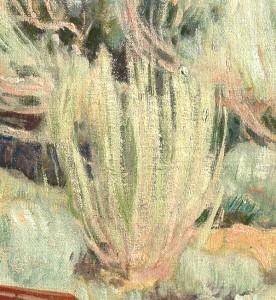
Vertical Patterns
The vertical patterns are most noticeable in the blanket and the braids worn by the men, but Hennings also used the patterns in nature: in the sky, the horse’s tail, and in the sagebrush.

Light
Dramatic light, bright color, and pattern activate this rather static scene. In spite of the dark, stormy sky, the sun throws hard shadows in the foreground. Bright light falls on the three men and the horse in the foreground of the painting, but the title subject, the dead rabbit, is obscured in dark shadows.
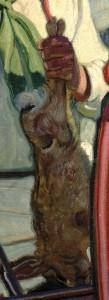
The Rabbit
Though the rabbit is hidden in the shadows, Hennings uses several techniques to signal its presence. All the men seem to have their attention focused on the rabbit and their rifles point to their recent kill. The vertical lines play another role here; if you follow the rider’s braids to the horse’s reigns to the other set of braids, your eye is led directly to the rabbit.
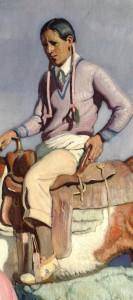
The People
Three men have a bold presence in Rabbit Hunt. Though they have quite individualized faces, we don’t know exactly who they are. Notice how each man is clothed in an individual way. The rider, for example is wearing a cross-cultural combination of trousers, a cuffed shirt, a tennis sweater, and moccasins.
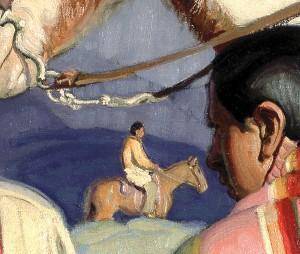
The In-between Spaces
The diamond shape under the horse’s neck creates a frame for another horse and rider. At first glance there is only one horse present, but look a little closer and you’ll see there are three in this painting.

The Striped Blanket
Striped blankets were used all the time, but Hennings would have selected the colors, pattern, and position of the blanket to suit his vision for the scene.
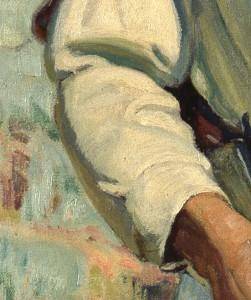
Colors in Unexpected Places
Bright colors are found throughout this painting in the highlights and shadows. Notice the bright red-orange near the horse’s hind leg, the yellow contours on the shadowed white clothing, and the light blue edges of the sagebrush in the center.
Funding for object education resources provided by a grant from the Morgridge Family Foundation. Additional funding provided by the William Randolph Hearst Endowment for Education Programs, and Xcel Energy Foundation. We thank our colleagues at the University of Denver Morgridge College of Education.
The images on this page are intended for classroom use only and may not be reproduced for other reasons without the permission of the Denver Art Museum. This object may not currently be on display at the museum.
